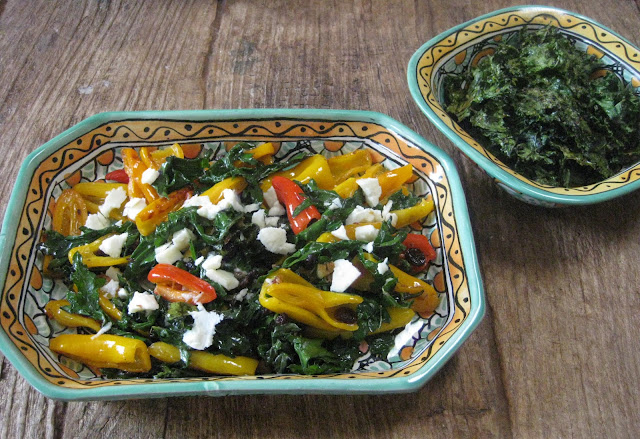Roasted Vegetables with Chimichurri
Roasted Vegetables with Chimichurri
by Victoria Challancin
A culinary specialty of Argentina, chimichurri, is a near-perfect sauce. Bursting with flavor, this perky, vibrant condiment is simple to make and has multiple uses and an interesting history. Can you get any better than that?
Variations abound, of course, but it is generally agreed that basically it is a condiment, found on almost every table in Argentina, that includes fresh parsley, lots of garlic, a souring agent such as vinegar or lemon juice, olive oil (a modern twist), red pepper flakes, and oregano. Of course, as soon as I type this I can hear some saying, "But what about the red version?" As I said, variations abound.
Chimichurri: A Bit of History
Like so many popular dishes, the true history of chimichurri is lost to time. Lost, perhaps, but that is not to say that many versions of its origin don't exist to titillate the imagination. Here are several:
- Named after a bon vivant Englishman named Jimmy Curry (also Jimmy McCurry and even a Scottish James C Hurray), who was traveling with the native troops of soldiers in Argentina fighting for independence in the 19th century and was supposedly the creator of the sauce, chimichurri is the way the locals pronounced his difficult-to-say name
- Many say it originated with the gauchos who created it to serve with the grilled meats they favored--both as a marinade and a condiment
- One perhaps silly story credits the Brits again by suggesting that the English-speaking colonists asked for their sauce, which they called "curry," by saying "Che mi curry," (instead of "Che mi salsa") in their poor Spanglish. This morphed from che mi curry into chimichurri
- Yet others say it came from the Basque animal herders in Argentina who used their own word tximitxurri, which means "a mixture of several things in no particular order." Can you guess that I just love this last one? I mean, I want to write a cookbook and call it A Mixture of Several Things in No Particular Order
Whatever the origin, the cooking world has embraced chimichurri .
There are many schools of thought on how the perfect chimichurri sauce should be made. I learned to make it from an Argentinian, who told me the only way to make it was to use cane vinegar. That's what makes it authentic. Yet, somehow, when looking at recipes in books and online, I have never seen cane vinegar listed as an ingredient. Others say you have to hand or machine chop all the ingredients before adding the oil; puréeing it in the blender with the oil gives an undesirable emulsion (and I agree with this generally). The oil can also be controversial. Traditionally, corn oil was supposedly the favorite; modern times have given us olive oil which, to me, is indispensable. Here is a version that I have used and taught countless times, though generally, I just throw it all together with no real recipe:
Recipe: Victoria's Chimichurri Sauce
(Recipe by Victoria Challancin)
6 to 8 cloves garlic, peeled
2 serrano chiles, stemmed
2 cups flat-leaf parsley leaves
1/4 cup cilantro leaves
2 tablespoons white vinegar
Leaves from one sprig fresh oregano
Salt to taste
2 cups extra-virgin olive oil
Chop garlic, chiles, parsley, cilantro, and oregano in a food processor or by hand. Transfer to a bowl. Add oil, vinegar, and salt. Stir to blend. Check and adjust consistency and flavor by adding more oil, chile, vinegar, or salt as preferred.
Enjoy!
Cook's Notes: As always, play with the recipe until it is yours. Try varying it by using lemon juice, red wine or sherry vinegar, or cane vinegar instead of the white vinegar which I listed in my recipe. Make a Cuban or Mexican version with pure cilantro. Dried oregano works well too, as do dried red pepper flakes instead of the serrano chiles. Add chopped tomato and/or red bell pepper for a change. Some people like a bit of onion, though I prefer it without. A teaspoon of cumin makes a nice change as well. I have also added green olives with great success.
Chimichurri Rojo
As much as I love bright, fresh herby green chimichurri, I also like the red version. Chimichurri, a favorite restaurant here in San Miguel de Allende that is unfortunately now closed, served a red one that was terrific. Norman Van Aken developed a similar one for Epicurious from his New World Kitchen cookbook. It is so worth checking out. You can find it here.
In a cooking class this week we made Roasted Vegetables with chimichurri, which were just dance-in-your-mouth fabulous. Used as both a marinade and in the roasting itself, the chimichurri worked perfectly with the vegetables. Vary the vegetables according to what is seasonal and on hand. We used baby asparagus, carrots, red bell pepper, chayote, and zucchini. Eggplant, fennel, turnips, beets (keep them apart!), and potatoes would also work well.
Recipe: Roasted Vegetables with Chimichurri
(Adapted slightly from a recipe from Foodista.com)
1 bunch (about 3 cups) parsley, stems removed
1 cup olive oil
3 tablespoons red wine vinegar
2 tablespoons dried oregano
1 tablespoon cumin
1 teaspoon salt
5 large cloves of garlic, minced
1/2 teaspoon dried red pepper flakes
2 pounds vegetables (see above for my choices)
For the chimichurri:
Place the parsley, olive oil, vinegar, oregano, cumin, salt, garlic, and pepper flakes in a food processor. Puree 30 seconds; then scrape the sides down and puree again.
Cut the vegetables in desired shapes. Toss the vegetables with approximately 1/2 cup of the chimichurri sauce and place on a baking tray. (I prefer to place the vegetables in separate piles so that if one type cooks more quickly, it is easier to remove before over cooking). Sprinkle with salt. Let sit for at least 30 minutes.
Preheat the oven to 400 degrees F. Roast the vegetables for 10 minutes, check and remove any that are sufficiently cooked, return the remaining vegetables to the ovens and cook for 10 more minutes. Check again, continuing in this manner until your vegetables are cooked to the desired doneness (I like mine a bit crisp). Serve hot or at room temperature.
Enjoy!
Chimichurri Sauce
Insanely Versatile--the Many Uses of Chimichurri
The bright, fresh herb condiment can be used on its own, as a marinade, and as a basting sauce for all manner of foods. Here are a few suggestions--just use your imagination (once you try it, you'll never want to be without it!):
- Use it as a marinade for seafood, chicken, meat (traditionally for offal and sausages particularly)
- Use it as a basting sauce for these same foods
- Add a bit more oil and vinegar (or not!) and use it as a vinaigrette for salads
- Serve it with or over cheese (very nice with goat's cheese)
- Serve it as a dipping sauce with good bread or on crostini
- Serve it as a salsa with zucchini or corn fritters
- Mix it into cooked white beans for a salad
- Serve it with pasta
- Drizzle it over grilled seafood (yummy on squid) and serve over baby lettuces
- Serve with any vegetable--beets, baby potatoes, carrots
- Put it on pizza
- Add to an omelette
- Drizzle over chicken- or vegetable-stuffed crêpes
- Spice up sandwiches with a bit of chimichurri
- Add to mayonnaise for a variation on aioli
- Serve it with empanadas
- Add to rice or cooked grains
- Add to yogurt or sour cream for a lovely sauce for vegetables or eggs
- Just put it on your table and let your guests go wild!
I will submit this post as an entry to the Weekend Herb Blogging event hosted this week by Terry of Crumpets & Co, begun by Kalyn Denny of Kalyn's Kitchen, and continued by Haalo of Cook Almost Anything. Thanks so much!
©Victoria Challancin. Recipes are for all to share, but please ask permission before using text or photos.


















































